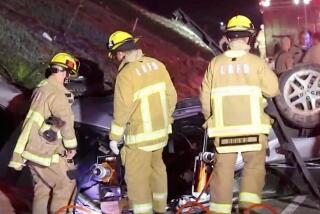Film Steers the Story of Freeway Onto Happier Path
The end of the Glendale Freeway means a lot of things to a lot of people, most of them bad.
To commuters from the north, it’s a bottleneck that squeezes four lanes of freeway into two lanes of road. To residents of Echo Park, it’s a sterile, noisy swath of concrete that cuts their community in two. To highway planners, it’s a public humiliation, a project that they couldn’t complete.
But to a young woman from Austria who is working on her master’s degree at UCLA, this most awkward piece of engineering has become the hero of a movie.
For her thesis in urban design, Silja Tillner is capturing the last half-mile of the Glendale Freeway on film. The story is something of a fantasy. In a 10-minute production, the miscast road will be transformed into a tree-lined parkway, healing the wounds of a torn community.
Technically, it’s as simple as Roger Rabbit. Tillner plans to use the animation technique exploited in the movie “Who Framed Roger Rabbit?” to illustrate her vision for reclaiming the Route 2 terminus.
The inspiration came from Tillner’s interest in film as a medium for lifting community planning off the two-dimensional plane of paper.
“It’s the only possibility to use the element of time in your design process, the time in which you perceive something,” Tillner said.
Her thesis coordinator, Richard Weinstein, doesn’t consider the technique entirely new, but said he has never seen it applied to a problem of such complexity and difficulty as the Glendale Freeway.
Fell to Opposition
Originally intended to connect to Beverly Hills, the freeway fell to regionwide political opposition in the late 1960s, said Pat Reid, spokeswoman for the state Department of Transportation. Dropped from the state freeway plan, the uncompleted freeway was cut off inelegantly in the middle of Echo Park.
Caltrans’ plan for the terminus remains provisional. It calls for minor modifications and the addition of lanes on Glendale Boulevard to ease the bottleneck, Reid said.
Tillner, 28, sees the problem from an entirely different perspective, influenced by her training at the Academy of Fine Arts in Vienna and a previous residency in a whimsical Moroccan village called Fez, where the traditional tool of urban orientation, the map, was of little use.
“You had to use your senses, your intuition,” Tillner said. “That is something I find very helpful generally, with the confusion you find in Los Angeles now. The classical tools of town planning have reached a limit.”
When she first investigated the Glendale Boulevard corridor as a class project last year, she fell for the hilly, lushly foliated, semi-Bohemian community whose “sensitive interaction between human needs and natural conditions” are still evident.
Tillner hoped to capture that original harmony of Echo Park and juxtapose it with the problem, imposed by outside interests whose needs “exceed the capacity of the land.”
The plot, developed in her thesis proposal, begins with the “psychological war between commuters and residents.” Film segments show elements that cannot exist together: “freeway off-ramp and elementary school; freeway under-path and entrance to church; family homes next to storage and car body shops.”
Then “a radical step is taken--the Glendale Freeway will be cut back to stop at the Golden State Freeway. The operation eliminates the hated object and replaces it with a new one that can be seen as the beginning of a new approach to the environment. . . . The most dramatic step is the freeway bridge and off-ramp, which will be transformed into landscaped, terraced gardens and a community center.”
This summer, Tillner and cameraman Dug Ward spent several days filming the freeway from many angles--the steep hills on either side, the desolate bridges that span it and the bitter end where the cars veer aside and the giant slab of concrete stops at a vacant lot.
The filming completed, Tillner has returned to the laboratory, where she is using a technique called rotoscoping to break the film into enlargements of individual frames. On a light table, she traces over each enlargement, producing a cartoon image on which she can let her imagination run free.
This will entail drudgery. To complete the film, she must make about 4,000 drawings.
More to Read
Sign up for Essential California
The most important California stories and recommendations in your inbox every morning.
You may occasionally receive promotional content from the Los Angeles Times.










